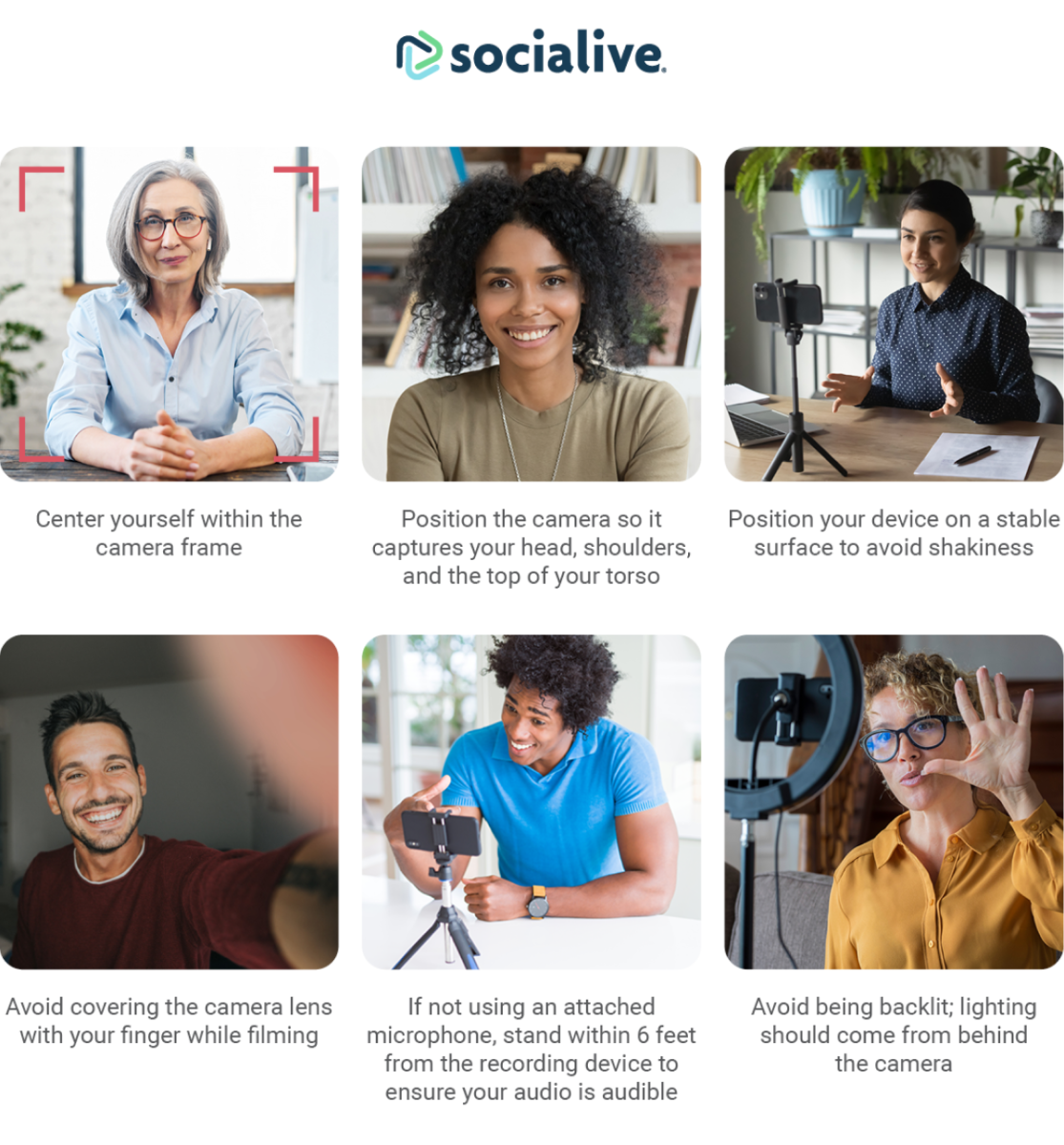Key takeaways:
Preparation is key to success in pre- and post-production
A checklist can help tech checks go smoothly
Confidence breeds confidence — try to comfort thought leaders
If you’ve ever been tasked with getting a thought leader on camera, you know it can be a tricky proposition.
Subject-matter experts, busy executives, employees, and just about anyone else who might feature in your content likely have something in common — they aren’t on-camera talent by trade.
That’s OK. Your job is to coach them up and get the best out of them.
Nerves, camera shyness, and a general lack of time can make it seem like getting someone who isn’t perfect on camera isn’t worth it.
But it is. Video is a powerful way to position thought leaders. No one can replicate their expertise, experience, and shining face. Of course, getting the best out of them isn’t easy.
And it’s important to nail the take because thought leadership is massively important in B2B marketing. In a recent report by LinkedIn and Edelman, 61% of decision-makers considered thought leadership more influential than product marketing, and 55% said that thought leadership is important to driving business.
Yet, only 33% of thought leaders believe they’re putting out high-quality material. We can help fix that by making your video of the highest quality possible.
We’ve compiled some quick tips to help you make your thought leaders comfortable and confident on camera.
Preparation saves time and headaches
“By failing to prepare, you are preparing to fail.” Advice by Benjamin Franklin worth way more than $100.
Each and every time you ask someone to go on camera, you need to make the experience as easy as possible for them.
You’d never expect an actor to go take the stage without knowing her lines — and even the best improv artists have a framework to work with.
Doing the heavy lifting ahead of time will boost your speaker’s confidence and increase buy-in. And it’s noticeable in the final video.
Send a rundown and script ahead of time
The first step for any wise producer is to prepare a quick information packet for your speaker with a script and production rundown. It’s crucial to get the right information to your thought leader. Not too much, or too little, just right.
You don’t want your thought leader to simply read from a script and have to think about every production note. Nor do you want them to show up and wing it. Rather, you want your presenter to comfortably speak through their information.
So think in bullet points.
Distill the production information down to who, what, where, and why. If the audience doesn’t need to know it, likely neither does your thought leader.
As for the script, if your thought leader isn’t used to creating their own talk track, you can help guide them. Simply ask that they provide a short summary of what they will cover, including any supporting information or graphics, and boil them down to 5-10 bullet points.
You’re in it together, so you can share the burden on the talk track. Just remind them to “help me help you.”
Use a checklist for your tech checks
You shouldn’t expect your thought leader to have the perfect setup. Even if you’ve sent camera equipment and a microphone for them to use, video isn’t their primary role. It’s yours.
It’s helpful to have a checklist ready to go, and perhaps include it with the information packet you send in advance.
Just remember to remind them of:
- Framing, lighting, and camera level
- Closing unnecessary browser windows and background apps
- Ensure the correct camera and audio device are connected
- Logistics like the Internet, silencing computer apps and their phone, and finding a quiet environment with a nice background
Many of these things are second nature for anyone who creates video regularly. But for your brilliant SME who doesn’t make content for a living, it’s best to help them out by giving them tips for their setup. Make sure all your bases are covered by having a checklist handy.
Add time for a practice run and warmups
It’s a little thing, but scope out 5–10 minutes to do a practice run.
Your thought leader may have done tons of warmups on their own, but it’s always different when the cameras are rolling. It doesn’t matter if it’s a short promo video or an hour-long panel, give your speakers space to get out any hiccups.
Instill confidence in your thought leader
Your thought leader is looking to you to be the professional during the session. They may know finance, healthcare, DEI, or artificial intelligence. But they might not know video.
If you come to the table calm, cool, collected, and confident, they will follow your lead. Confidence breeds confidence, so do your best to prepare to win, and your thought leader will bring their A-game, too.
Use a teleprompter
Don’t be a hero. No matter how well-versed someone is on camera, it’s always better to have support. A built-in teleprompter can help your speaker do their best work.
And we know — the last thing you want is for your thought leader to look like they are obviously reading a script. But reading through a script once or twice can help nail the material. Even professional actors do table reads!
Then for the main event, your SME can just use their teleprompter for the bullet points to make sure they nail their talking points.
Record when possible, practice ahead of livestreams
One of our other tips is to opt for the safety of recording when possible. Sure, this might mean an extra step, but if you’re using Socialive, recording and then sending out your livestream in a live-to-tape workflow is seamless.
Unless your content absolutely needs to be live, such as if it’s a Q&A session or has some other digital audience interaction, recording can reduce your presenter’s stress. It gives your thought leader peace of mind, knowing that they don’t have to be perfect.
But if you do choose to go live with an inexperienced or nervous speaker, make sure you schedule that practice run.
It doesn’t need to be a full walkthrough, just enough time to get loose, get the stumbles out of the way, and hone in on the talk track. This is especially helpful for any busy individual who is pulled from meeting to meeting.
Always do an extra take
If this isn’t a livestream and you have the benefit of recording, always ask for one more take. Note: this is just a recommendation for a quick segment or statement. We’re not saying you should ask a thought leader to redo their hour-long panel!
Time is valuable, of course, but it’s much easier to get everything you need and have redundant footage than to have to try and fix something in post-production.
You might find in the final take that your presenter has more energy. They’re more comfortable. Maybe the lighting coming from their window is just better. Either way, it’s great to have options for editing.
Things your thought leader can do
Now that we’ve given you, the producer, plenty to think about, here are just a few tricks that your thought leader can do to feel more comfortable.
Force a laugh
Laughing releases endorphins. People feel better and more comfortable when they laugh, so it’s a decent warmup to get in a few chuckles before going on camera.
This can easily be paired with doing a vocal exercise. Who can resist a grin after doing a few Ron Burgundy–style “unique New Yorks” or a Peyton Manning-eque “Omaha” cadence?
Pick a comfortable area
The benefit of working in a platform that is remote and captures video from anywhere is that it can be done, well, from anywhere.
So before hitting record or going live, consider letting your presenter pick a place that is their physical “happy place.” Of course, it still has to be a quiet area with a good background and nice lighting.
You’d be amazed the boost in performance when people are in their element. Not everyone is cut out to have the bright lights of a studio on them. Rather than forcing a sterile environment on them, let your thought leader pick a spot where they feel at their best.
Sit tall, smile, and power pose
OK, we understand how ridiculous it sounds, but hear us out.
There’s a reason every self-help guru under the sun talks about “power posing” — it works. Body language has an impact on how a person feels. It might sound like “fake it till you make it,” but anyone who has worked as talent on stage or on camera knows how important posture is.
Yes, smiling also factors in.
For our radio producers and podcasters out there, you understand there is an audible difference when you smile. You project your voice, you’re more upbeat.
If nothing else, if your thought leader appears to be in a cheerful mood, it lifts the spirits of everyone around them. It makes for a much more hospitable work environment, making it easier to get the best out of everyone.
Always coach up your thought leaders
The better you prepare yourself and your thought leader, the easier it will be to get great content out of them.
End-to-end video platforms like Socialive make it easy to record, edit, and publish your videos or to run a livestream, but your presenters will be the ones to truly make content great. Clearing the way for them to be at their best doesn’t have to be difficult, it just requires a bit of coaching and attention to detail.
For those who might not be seasoned producers but want to get started, be sure to download our guide on how to make video a part of your strategy. It contains additional tips and tricks to transform your video comms.


